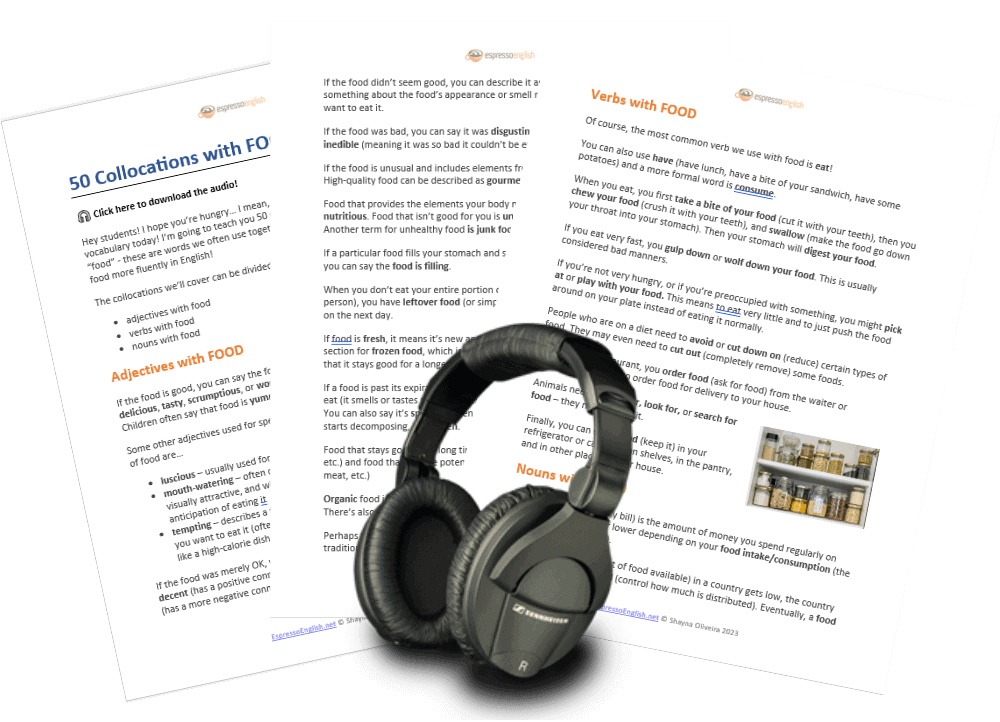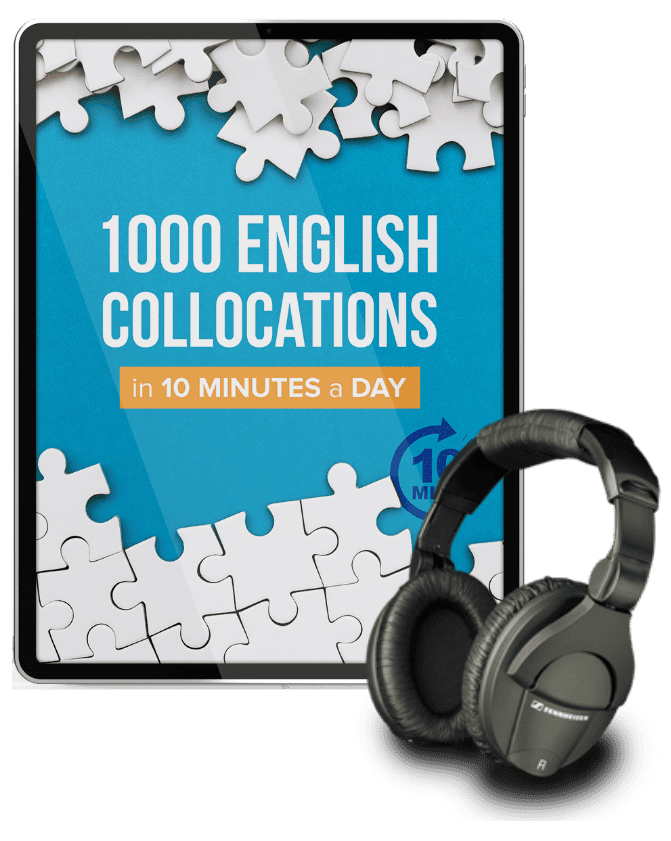
1000 English Collocations E-Book
I hope you’re hungry… I mean, hungry to learn some new vocabulary today! I’m going to teach you 50 common collocations with the word “food” – these are words we often use together – so you’ll be able to talk about food more fluently in English!
There’s a lot of vocabulary in this lesson, and I’ve made a free lesson guide available for you to download – click here to get it. The collocations we’ll cover can be divided into 3 groups: adjectives with food, verbs with food, and nouns with food. We’ll start with adjectives.
Adjectives with FOOD
If the food is good, you can say the food is delicious, tasty, scrumptious, or wonderful. Children often say that food is yummy.
Some other adjectives used for specific types of food are…
- luscious – usually used for fruits that are fresh and juicy
- mouth-watering – often describes foods with a pleasant aroma or that are visually attractive, and which make your mouth produce saliva in anticipation of eating it
- tempting – describes a food that makes you want to eat it (often an indulgent food like a high-calorie dish or sweet dessert)
If the food was merely OK, you can describe it as decent (has a positive connotation) or mediocre (has a more negative connotation).
If the food didn’t seem good, you can describe it as unappetizing – something about the food’s appearance or smell made you not want to eat it.
If the food was bad, you can say it was disgusting, horrible, or even inedible (meaning it was so bad it couldn’t be eaten).
If the food is unusual and includes elements from other countries, it is exotic. High-quality food can be described as gourmet or fine.
Food that provides the elements your body needs is nutritious. Food that isn’t good for you is unhealthy. Another term for unhealthy food is junk food.
If a particular food fills your stomach and satisfies you, you can say the food is filling.
When you don’t eat your entire portion of food (regular amount of food for one person), you have leftover food (or simply leftovers) which you can eat later, or on the next day.
If food is fresh, it means it’s new and good to eat. Many supermarkets have a section for frozen food, which is stored in the freezer at very low temperatures so that it stays good for a longer time.
If a food is past its expiration date and is no longer safe to eat (it smells or tastes strange), then the food has gone bad. You can also say it’s spoiled. When food is very old and starts decomposing, it is rotten.
Food that stays good for a long time is non-perishable (such as rice, beans, sugar, etc.) and food that has the potential to go bad quickly is perishable (such as fruit, meat, etc.)
Organic food is grown in a natural way without using dangerous chemicals. There’s also processed food which has gone through a lot of changes in factories.
Perhaps the best kind of food is homemade – food that is prepared at home, in a traditional way, by a real person.
Verbs with FOOD
Of course, the most common verb we use with food is eat! You can also use have (have lunch, have a bite of your sandwich, have some potatoes) and a more formal word is consume.
When you eat, you first take a bite of your food (cut it with your teeth), then you chew your food (crush it with your teeth), and swallow (make the food go down your throat into your stomach). Then your stomach will digest your food.
If you eat very fast, you gulp down or wolf down your food. This is usually considered bad manners.
If you’re not very hungry, or if you’re preoccupied with something, you might pick at or play with your food. This means to eat very little and to just push the food around on your plate instead of eating it normally.
People who are on a diet need to avoid or cut down on (reduce) certain types of food. They may even need to cut out (completely remove) some foods.
If you’re in a restaurant, you order food (ask for food) from the waiter or waitress. You can also order food for delivery at your house.
Animals need to hunt for, look for, or search for food – they need to find it.
Finally, you can store food (keep it) in your refrigerator or cabinets, on shelves, and in other places in your house.
Nouns with FOOD
Your food bill (or grocery bill) is the amount of money you spend regularly on food. It will be higher or lower depending on your food intake/consumption (the amount of food you eat).
If the food supply (amount of food available) in a country gets low, the country may have to ration its food (control how much is distributed). Eventually, a food shortage (lack of sufficient food) may turn into a food crisis (very serious problem with not enough food).
Restaurants and food trucks (vehicles equipped with a kitchen that serves food) must worry about food hygiene or food safety when they prepare food for clients. If someone eats food that has gone bad, they might get food poisoning (getting sick as a result of bacteria in the food).
Finally, some countries provide food stamps to poor people – coupons that allow them to get food from supermarkets for free. Some communities also have food banks – places that distribute food to families who need it.
Wow, those were a lot of expressions – and I don’t expect you’ll remember them all perfectly! That’s why it’s a good idea to download the free lesson guide, so you can review and also test yourself with the quiz.
And if you’d like to take the next step in learning from me, check out my e-book with 1000 collocations on all sorts of topics.


